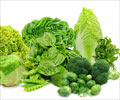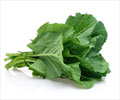Less Known Nutrient Dense Leafy Greens
The health benefits of green leafy vegetables have always been advocated by nutritionists. Green leafy vegetables are a goldmine of nutrients aiding in diabetes management, weight loss, cancer prevention and improved immunity.
Low in calories and high in fiber which promotes satiety, greens are a must-have for weight watchers. Greens contain nutrients like lutein and zeaxanthin that protect against cataract and age-related macular degeneration. High magnesium content and low glycemic index of greens make it an ideal food for type-2 diabetics.

The combination of carotenoids, flavonoids and phytochemicals provide the antioxidant boost to greens by lowering the risk of cancer.
All green leafy vegetables are abundant in chlorophyll, which is a green pigment that plays a significant role in blood clotting, detoxification, wound healing, strengthening the immune system and promoting digestive health.
While broccoli, cauliflower, lettuce and cabbage are the most popularly eaten greens, lesser known greens like beet greens, arugula, bok choy, collard greens and watercress boast of similar health benefits and must be incorporated in our daily diet.
It is interesting to know that research conducted by the William Patterson University in New Jersey to determine the most nutrient dense vegetables and fruits, ranked watercress as the most nutrient-dense vegetable followed by Chinese cabbage, chard, beet greens, spinach and chicory.
1. Watercress
Watercress is an aquatic plant, which was used by Romans as a nerve tonic as well as an aphrodisiac.
It is the richest dietary source of â-phenylethyl isothiocyanate (PEITC) which possesses powerful anti-cancer properties.
A study published in the British Journal of Clinical Pharmacology demonstrated that dietary nitrates present in foods like watercress can help lower hypertension, inhibit platelet aggregation as well as improve endothelial dysfunction.
Another study published in the American Journal of Clinical Nutrition suggests that daily intake of about two cups of watercress for eight weeks could reduce DNA damage linked to cancer by 17 percent.
Watercress contains alpha-lipoic acid, which helps lower glucose levels, increases insulin sensitivity and prevents oxidative stress-induced changes in diabetics.
A 100 gram serving of raw watercress provides 11 calories, 1 gram carbohydrate, 2 grams protein and meets 312.5% Recommended Dietary Allowance (RDA) of Vitamin K. Watercress can be added to salads and sandwiches.

2. Bok Choy
Bok choy, also known as Chinese cabbage, is a popular winter season vegetable, which grows in China and Korea.
Bok choy is an excellent source of brassinin, which lowers the risk of cancer as well as helps in healing damage caused by cancer cells.
It is rich in iron, which boosts ferritin levels and helps combat hair fall.
The high bio-availability of calcium combined with abundant Vitamin K content makes bok choy a must-include for stronger bones.
A 100 gram serving of raw bok choy provides 13 calories, 2 grams each of carbohydrates and proteins and meets 89% RDA of Vitamin A. Bok choy can be eaten raw or added to stir-fries, wraps and soups.
3. Chard
Chard is a variant of Beta vulgaris which is quite popular in Mediterranean cooking.
Chard contains syringic acid, which is a flavonoid that inhibits the activity of alpha-glucosidase enzyme resulting in fewer carbohydrates being broken down to simple sugars as well as stable blood sugar levels in diabetics.
It is abundant in biotin, which improves hair texture and luster.
A 100 gram serving of raw chard provides 19 calories, 4 grams carbohydrates, 2 grams protein and meets 122% RDA of Vitamin A. Chard can be used as a substitute for other leafy greens in green smoothies.
4. Arugula
Arugula, also popular as garden rocket, rucola, roquette, and colewort is an herb of Mediterranean origin.
A study published in the World Journal of Gastroenterology highlighted the anti-ulcer activity of arugula extract. The anti-ulcer property of arugula can be contributed to its prostaglandin-mediated activity and a wide variety of antioxidants.
According to traditional Arabic medicine, arugula acts as an aphrodisiac boosting sexual desire and performance. A 100 gram serving of raw arugula provides 25 calories, 4 grams carbohydrates, 3 grams protein and meets 135.75% RDA of Vitamin K. Just like other leafy greens arugula can be added to pasta, casseroles and sauces.

5. Collard Greens
Collard greens, a native to the Mediterranean region are used extensively in South American cuisine.
A study published in the Nutrition Research Journal highlighted that steamed collard greens possess the strongest bile acid binding capacity among cruciferous vegetables which are an indicator of its cholesterol-lowering properties.
They are a good source of choline which promotes sleep, muscle movement, learning and aids in transmission of nerve impulses.
Being a rich source of isothiocyanate sulforaphane, collards possess powerful anti-inflammatory properties.
A 100 gram serving of raw collards provide 32 calories, 5 grams carbohydrates, 3 grams protein and meets 59% RDA of Vitamin C.
6. Beet Greens
Beet greens refer to the leafy greens of beetroot which impart a very subtle flavor.
A rich source of nitrates, beet greens play a role in lowering hypertension due to their vasodilator properties.
Betalain pigments in beet greens stimulate the production of glutathione, which plays a vital role in liver detoxification.
A 100 gram serving of beet greens provides 22 calories, 4 grams carbohydrates, 2 grams proteins and meets 127% RDA of Vitamin A. Beet greens with feta pasta make a delicious combination.
7. Mustard Greens
Mustard greens are a popular winter vegetable imparting a peppery flavor.
Mustard greens contain sinigrin and gluconasturtiin which get converted to allyl isothiocyanate and phenethyl isothiocyanate which possess anti-cancer and anti-inflammatory properties.
Phytonutrients called glucosinolates present in mustard greens play an important role in detoxification by activating the detoxification enzymes.
A 100 gram serving of raw mustard greens provide 27 calories, 5 grams carbohydrates, 3 grams proteins and meets 117% RDA of Vitamin C. Chopped mustard greens with goat cheese, pasta and pine nuts tossed with olive oil make a great dish.








